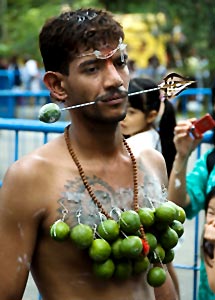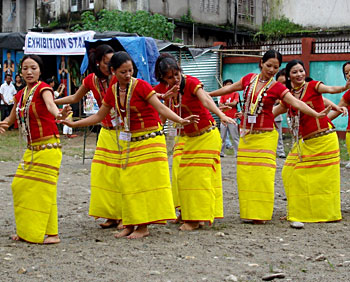The word itself appears to be the combination of two words Kavat and adi intended to mean the vow made to walk the distance to the place of pilgrimage on foot. There are different kinds of this Kavadi. Out of which three are worth mentioning.
There is one going by the name of Annakavadi. It consists in the devotee going from house to house begging for cooked rice not with the idea of satisfying his own hunger, but to offer the gathering to God. An offering to God generally means an offering to humanity. Hence the vow of taking Annakavadi is really a vow to beg food from others. And the inner meaning is going from door to door and place to place, and to offer the same to the hungry and needy in God`s name. People have begun to entertain the belief that living a life of laziness after satisfying the hunger with the food obtained by begging would bring them nearer to God. The second kind of Kavadi is called the Palkavadi or the vow of begging for milk from house to house to be utilized in the service of God. Usually the milk collected is poured upon the image of the deity, collected again in a vessel and disposed of either by distributing it among the children or by utilizing the same for satisfying personal hunger and demand.
 The third variety of Kavadi is perhaps the one observed by people without the possibility of its degenerating into selfish use in the end. It consists in making a vow that he or she would make a pilgrimage to the one or the other of the temples to worship the deity there. It is nothing but the offering of the devotee`s energy to the deity. In the elementary stage it consists in walking to the temple of the deity, but in advanced stages it was intended to mean the use of the individual`s energy in the service of God. This actually means the service of humanity as expressed from the fact that a Samaradhana or feeding of the people is performed after all such observance of vows. Though in some cases people may not find it convenient to perform it.
The third variety of Kavadi is perhaps the one observed by people without the possibility of its degenerating into selfish use in the end. It consists in making a vow that he or she would make a pilgrimage to the one or the other of the temples to worship the deity there. It is nothing but the offering of the devotee`s energy to the deity. In the elementary stage it consists in walking to the temple of the deity, but in advanced stages it was intended to mean the use of the individual`s energy in the service of God. This actually means the service of humanity as expressed from the fact that a Samaradhana or feeding of the people is performed after all such observance of vows. Though in some cases people may not find it convenient to perform it.
There is a philosophical and spiritual side to all observances of Hindu religious rites, ceremonies and also customs. In this case also there is an interesting philosophical and spiritual principle involved in the custom and the Kavadi carried to the temple gives an idea of it.
The wise sages who originated the custom wanted to make the observance of it interesting. A man in a village might have taken this vow of Kavadi which strictly means the sacrifice of a walk to the temple. He might have walked to the temple several times after the taking of the vow and may wish to set off one such walk against the promised one to the deity. Thus the spirit needed may be lost sight of. So an object called Kavadi in the form of a segment of a circle was made, decorated and carried to the temple with great veneration to install in the mind of the observer with the right spirit.
As all religious rites appeal to invisible worlds, the Kavadi is the fittest form to represent the blessings in the invisible world through the mercy of the invisible deity who for ever eludes our grasp.
The origin of Kavadi-bearing is said to be that once God Siva gave in Mount Kailas to sage Agastya; but the sage left them there in a forest and returned to the south. When at another time he was about to start to the north with the set object of bringing these two divine hillocks, his disciple Itfumban, offered to carry them himself. Accordingly, Itfumban proceeded to the forest following the directions given by his master. When he was at a loss to know how to lift them, the Danda or stick of Brahma stood over the hillocks while the snakes of the earth served in place of Topes to enable him to carry them, duly fastened to the rod. He thereupon lifted them, bore them on his shoulders and brought them to the south. While nearing the forest near Palni in Dindigal Taluk, he kept them on the ground to rest a while. On attempting to lift them again, he found them to his surprise permanently fixed to the ground at that spot.
To know the reason thereof, he got over them and there he noticed a youth with a stick in one hand and wearing only underwear. On being questioned as to why the hillocks would not move, he claimed them as his own. Then an altercation ensued with the result that Itfumban fell senseless in the scuffle. Recovering from the faint and recognizing in the boy the divine Subrahmanya. Itfumban prayed to him that those offering vows bearing Kavadi similar to the one adopted by him in bringing these sacred hillocks, should be blessed fully and relieved from all difficulties. This was granted which accounts for the bearing of Kavadi by Hindus on all-important festive occasions. The subject is fully dealt with in the South Indian Festivities under the head `Skanda Sashti`.



















